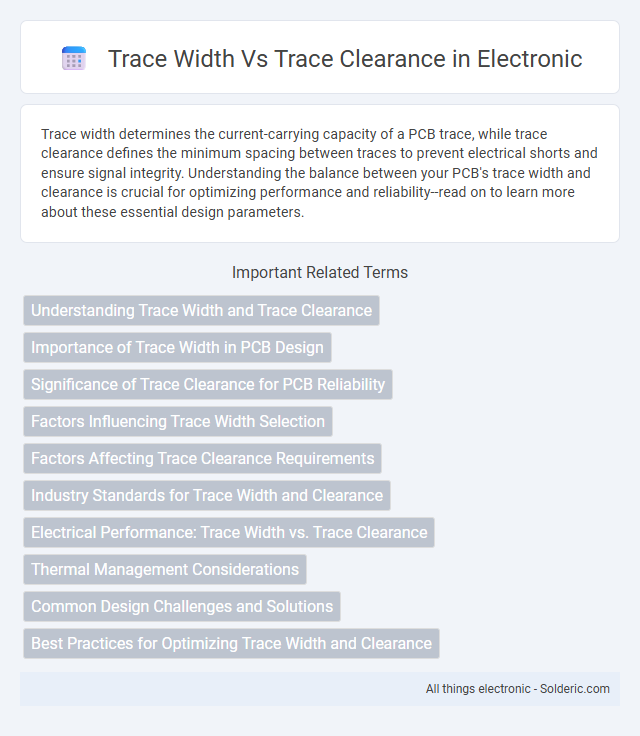Trace width determines the current-carrying capacity of a PCB trace, while trace clearance defines the minimum spacing between traces to prevent electrical shorts and ensure signal integrity. Understanding the balance between your PCB's trace width and clearance is crucial for optimizing performance and reliability--read on to learn more about these essential design parameters.
Comparison Table
| Aspect | Trace Width | Trace Clearance |
|---|---|---|
| Definition | Width of a conductive path on a PCB | Distance between adjacent conductive paths on a PCB |
| Function | Determines current capacity and resistance | Prevents electrical shorts and interference |
| Unit | Typically micrometers (um) or mils | Typically micrometers (um) or mils |
| Impact on PCB | Affects heat dissipation and signal integrity | Ensures reliable insulation and minimizes crosstalk |
| Design Considerations | Based on current load and manufacturing limits | Based on voltage clearance and manufacturing tolerances |
| Example Values | Width: 6 mils for 1 A current | Clearance: 6 mils minimum for 50 V |
Understanding Trace Width and Trace Clearance
Trace width determines the current-carrying capacity and resistance of a PCB trace, directly impacting signal integrity and thermal performance. Trace clearance defines the minimum distance between adjacent traces, critical for preventing electrical shorts and ensuring proper insulation according to voltage requirements. Optimizing both trace width and clearance is essential for reliable circuit functionality and adherence to manufacturing standards like IPC-2221.
Importance of Trace Width in PCB Design
Trace width in PCB design directly impacts current-carrying capacity, signal integrity, and thermal management. Wider traces reduce electrical resistance and heat buildup, preventing potential damage and ensuring reliable performance. Optimizing your trace width is crucial for maintaining circuit efficiency and longevity.
Significance of Trace Clearance for PCB Reliability
Trace clearance plays a critical role in PCB reliability by preventing electrical shorts and arcing between adjacent traces, especially in high-voltage or high-frequency circuits. Maintaining adequate trace clearance ensures proper insulation and reduces the risk of signal interference, enhancing overall circuit integrity and performance. Your PCB design should prioritize trace clearance to meet industry standards and ensure long-term device reliability under varying environmental conditions.
Factors Influencing Trace Width Selection
Trace width selection depends on factors such as current-carrying capacity, thermal dissipation, and signal integrity requirements. Wider traces reduce resistance and heat buildup, supporting higher currents, while narrower traces allow for denser circuit layouts and improved impedance control. Your PCB design must balance these considerations with trace clearance rules to ensure electrical isolation and prevent short circuits.
Factors Affecting Trace Clearance Requirements
Trace clearance requirements are influenced primarily by voltage levels, with higher voltages demanding wider gaps to prevent electrical arcing. Manufacturing capabilities and PCB material properties also significantly impact minimum clearance standards, as tighter tolerances require precision fabrication and materials with higher dielectric strength. Environmental conditions such as humidity and contamination further dictate clearance to maintain reliable insulation and prevent short circuits.
Industry Standards for Trace Width and Clearance
Industry standards for trace width and clearance are primarily governed by IPC-2221 and IPC-7351 guidelines, which specify minimum dimensions based on manufacturing capabilities and electrical requirements. Trace width affects current-carrying capacity and heat dissipation, while clearance ensures proper insulation and prevents signal interference or short circuits on printed circuit boards (PCBs). Your PCB design should adhere to these standards to maintain reliability, meet safety regulations, and optimize performance across various electronic applications.
Electrical Performance: Trace Width vs. Trace Clearance
Trace width directly influences the current-carrying capacity and resistance of a PCB trace, while trace clearance affects the voltage isolation and risk of electrical arcing. Wider trace widths reduce resistance and improve thermal dissipation, enhancing overall electrical performance, whereas adequate trace clearance prevents short circuits and ensures signal integrity by minimizing crosstalk and electromagnetic interference. Your PCB design must balance trace width and clearance to optimize both current flow and reliable voltage isolation.
Thermal Management Considerations
Trace width directly affects the thermal dissipation capacity of a PCB, as wider traces reduce resistance and minimize heat buildup during current flow. Trace clearance impacts the risk of electrical arcing and helps maintain the necessary insulation to prevent hotspots that can degrade thermal performance. Optimizing both trace width and clearance is critical for effective thermal management, ensuring reliable operation and longevity of electronic components under varying load conditions.
Common Design Challenges and Solutions
Trace width and trace clearance are critical factors in PCB design that directly impact signal integrity and manufacturing yield. Common challenges include ensuring sufficient trace width to handle current without excessive heat buildup while maintaining adequate clearance to prevent electrical shorts and crosstalk in high-density layouts. Solutions involve adhering to IPC standards for minimum spacing, using simulation tools to optimize trace dimensions, and selecting appropriate materials to balance performance and reliability.
Best Practices for Optimizing Trace Width and Clearance
Optimizing trace width and clearance is crucial for ensuring signal integrity and preventing electrical shorts in PCB design. Best practices include adhering to manufacturer specifications, maintaining adequate clearance to avoid crosstalk and arcing, and adjusting trace width based on current-carrying capacity using IPC-2221 standards. Utilizing tools like CAD software to simulate electrical performance helps achieve the ideal balance between trace width and clearance for reliability and manufacturability.
trace width vs trace clearance Infographic

 solderic.com
solderic.com